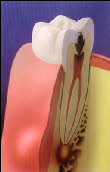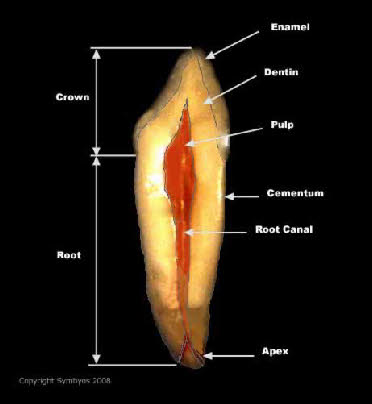Root Canals
“Root Canals” get a bad rap. You will probably think I’m crazy for saying this…. But, in my opinion, the “Root Canal” is one of the most peaceful procedures in dentistry. The reason everyone (society) thinks root canals are synonymous with “Chinese water torture” is the following:
When someone comes into the office with a tooth ache or has some type of swelling/ inflammation around a tooth (requiring a root canal), the pH (acidity) of ANY infected area is very low. A low pH is the body’s natural attempt to fight off infection. A low pH (or acidic environment) shuts down the effectiveness of anesthetic. When anesthetic doesn’t work, the patient cannot get numb. It is inevitable that the procedure IS torture.

While most dentists with an infected (acidic) situation will attempt a root canal immediately, my standard protocol is to put the patient on an Antibiotic (like Penicillin or Clindamycin) and reschedule the root canal to a later date. Once the antibiotic has the infection under control, and the acidic environment is neutralized, I can easily anesthetize my patient.
When a patient is properly anesthetized, the root canal procedure is easier, more peaceful, and less painful than most basic fillings, even cleanings!
I know that many may not believe this, but, in my office, it is common for patients fall asleep during root canals! The reason for this is that there is not a lot of drilling during a root canal procedure. It is a rhythmic and quiet procedure. Patients are comfortable and calm because they are numb. I use a small computer (to right) to guide all of my instrumentation. It’s a gentle procedure performed with precision and finesse.

The biggest problem my patients have with rootcanals is a tired jaw from staying open. For this, I offer “bite blocks” or small plastic wedges on which patients can rest their teeth. Many patients love this. Nitrous Oxide helps as well!
So, to reiterate, people associate root canals with pain because they were already in pain prior to the root canal. And, when most dentists “heroically” attempt to perform a root canal the same day as the infection, it’s like adding pain to pain. Gasoline to fire.

Another thing that eases a patient’s mind with root canals is a basic understanding of the procedure. Many people think a “root canal” is when the dentist “removes the root”. This could not be further from the case. I am not removing the root or any part of the root.
A tooth is like a house with thick walls and a hollow chamber inside. That hollow chamber narrows to a pin sized hollow tunnel extending down the center of the tooth root. At the very tip (or apex) of the root, the tunnel ends at a small pin sized opening. That opening is the entrance and exit for the nerve, artery, and vein that supply the tooth.

When a person has a “cavity”, bacteria (which feed on sugar) release their bi-
Bacteria work their way through the outer wall of the tooth “house” until they penetrate into the “chamber” or pulp. Once this happens, bacteria flourish, feeding on the nerves, arteries, veins, and nutrients of the pulp. As bacteria devour the soft tissue of the pulp, they travel down the length of the canal “tunnel” until they reach the very tip (or apex).
The body responds to this bacteria invasion by forming an immune response at the root apex, thus, forming an abscess. Taking penicillin can alleviate the abscess outside the root apex, but since the blood supply extending into the tooth has been destroyed, it cannot touch the bacteria hiding inside the tooth “house”. This is the reason why Penicillin can alleviate symptoms but not cure the source of the problem.

The only way to cure the problem source is a root canal. A root canal is nothing more than the process of cleaning bacteria from the pulp and canals. With a root canal, all decay is removed, the tooth is isolated with a sterile piece of latex called a “rubber dam,” access is gained into the chamber through a small opening in the top of the tooth, and the canals are gently cleaned with long thin files (see to right) that look like toothpicks. After the pulp chamber and canals are cleaned with files and irrigated with a cleaning agent, the canals are filled with a sealing material called gutta percha.

A root canal is nothing more than a disinfecting procedure. It disinfects the tooth from the inside out. The administration of Penicillin (or other antibiotic) disinfects from the outside in. The combination of these two agents is the best approach.
Overall, from a patient’s perspective, there is some brief “drilling” in the beginning of the appointment to access the pulp. You will then feel gentle vibrations from a computer that I use to instrument (clean) the canals. There is irrigation and suctioning between files. You will also hear some beeps and bleeps from another computer which measures lengths and tracks file instrumentation.
It is very often that I have patients tell me after root canals, “Wow, that was not nearly as bad as I anticipated…” or “I don’t know what I was afraid of??”
So, if you have a tooth ache and keep putting off going to the dentist, Penicillin may help temporarily. But, the infection will remain in that tooth. Also, you risk forming a tolerance to penicillin. Penicillin tolerance can be a dangerous situation and can send you to the hospital!
An infection in a tooth is similar to having a “cold” or the “flu”. It is an infection your body is trying to fight but can’t completely kill because its hiding in the tooth.
Very often, I have had patients tell me that, following root canals, they just “feel better.” The reason for this is that their body is no longer working overtime to fight an untouchable infection.
Furthermore, untreated infections can permeate into the surrounding tissues around the tooth and even into other parts of the body (ie. joint replacements, heart murmurs, stents, The BRAIN!!).
So, be careful!!
I try to make the root canal procedure as tolerable as possible (see NITROUS OXIDE section!!!) so mind your health and give me a call!!


